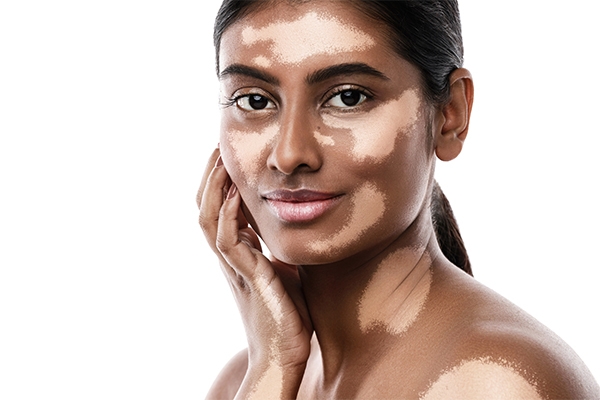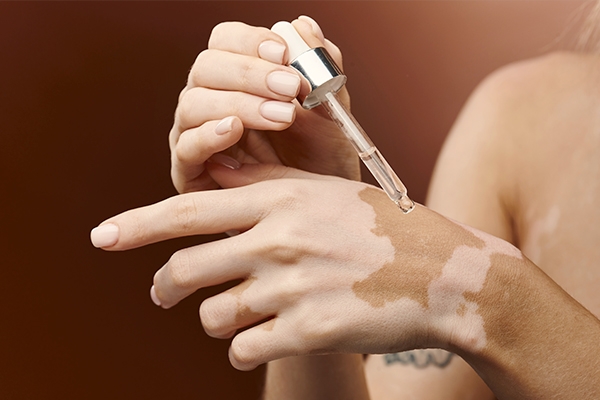Understanding Vitiligo: When Skin Loses Its Color

Vitiligo is a skin condition that causes the loss of natural pigmentation (melanin), resulting in white patches on various parts of the body, such as the hands, face, and feet.
Vitiligo doesn’t only affect the skin. It can also impact the color of the hair, eyebrows, eyelashes, and even the eyes.
Although vitiligo is not contagious and poses no serious medical threat, the visible skin changes often affect a person’s self-confidence.
Read more: Vitiligo.
What causes vitiligo?
Vitiligo occurs when the immune system mistakenly attacks melanocytes.
The cells responsible for producing melanin, the pigment that gives color to the skin, hair, and eyes. As a result, the affected areas lose their natural pigment and appear white.
Sizes of vitiligo patches
Vitiligo patches may vary in size:
- Macules: Small white spots less than 1 cm in diameter.
- Patches: Larger white spots over 1 cm in size.
Who can get vitiligo?

Vitiligo can affect anyone, regardless of race, gender, or age. However, its symptoms tend to be more noticeable in people with darker skin.
- Approximately 1% of the global population is affected by vitiligo.
- It typically appears before the age of 30.
- The risk increases for people with autoimmune diseases such as type 1 diabetes, lupus, psoriasis, rheumatoid arthritis, thyroid disorders, anemia, or Addison’s disease.
How does vitiligo spread?
Vitiligo often begins with small, white patches on areas such as the hands, face, or feet. Over time, these patches may remain localized for years or slowly spread.
Affected areas may include:
- The inside of the mouth and nose (mucous membranes)
- Genitals and anus
- The inner ear
- The eyes (including the iris and retina)
The extent of vitiligo spread varies from person to person. Some individuals may develop only a few small patches, while others may experience widespread loss of skin color.
Common signs and symptoms of vitiligo
The main symptom of vitiligo is the loss of skin pigmentation in specific areas. These white patches are often more noticeable on darker skin. Other signs may include:
- White patches on the skin or mucous membranes (such as the inside of the mouth or nose).
- Hair growing in the affected area turning white, silver, or gray (including eyebrows, eyelashes, or scalp hair).
- A mild itching sensation that may occur before a white patch appears.
What causes vitiligo?
The exact cause of vitiligo remains unknown, but several factors are believed to contribute:
- Autoimmune response: The immune system mistakenly attacks pigment-producing cells
- Genetic factors: Changes in over 30 different genes may increase the risk
- Environmental triggers, such as excessive UV exposure or certain chemicals
- Physical or emotional stress: Injury, trauma, or significant emotional stress can trigger vitiligo patches, especially in genetically predisposed individuals
Can vitiligo lead to complications?
While vitiligo itself is not contagious or dangerous, it can lead to both physical and emotional challenges. Potential concerns include:
1. Increased sensitivity to sunlight
Lacking melanin, affected skin is more prone to sunburn. Instead of tanning, these areas can turn red and feel painful.
2. Changes in eye color
Vitiligo may cause slight changes in eye pigmentation, such as in the iris, although this rarely affects vision.
3. Risk of other autoimmune conditions
People with vitiligo may be more susceptible to other autoimmune disorders, including hypothyroidism and anemia.
4. Psychological impact
Changes in skin color can influence emotional well-being, such as:
- Feelings of embarrassment or self-consciousness
- Low self-esteem
- Anxiety or depression
- Social withdrawal or isolation
If you or someone close to you is experiencing emotional distress due to vitiligo, it's essential to seek support from healthcare professionals, psychologists, or support communities.
Does vitiligo need treatment?

Vitiligo doesn’t always require treatment, especially if it doesn’t cause physical discomfort or affect daily life. However, treatment can help improve the appearance of the skin and boost self-confidence.
Standard treatment options include:
- Topical corticosteroids or immunomodulators to help restore skin color
- Light therapy (phototherapy), such as narrowband UVB
- Surgical options, like skin grafting or melanocyte transplants
- Cosmetic camouflage using makeup or concealing products to cover patches
Consult a dermatologist to determine the most appropriate treatment approach.
Vitiligo is manageable with the right knowledge and support.
Vitiligo is a complex skin condition, but it is not dangerous or contagious. Understanding the condition can empower you to manage it healthily, physically and emotionally.
If vitiligo is affecting your quality of life, don’t hesitate to seek professional guidance and emotional support.



